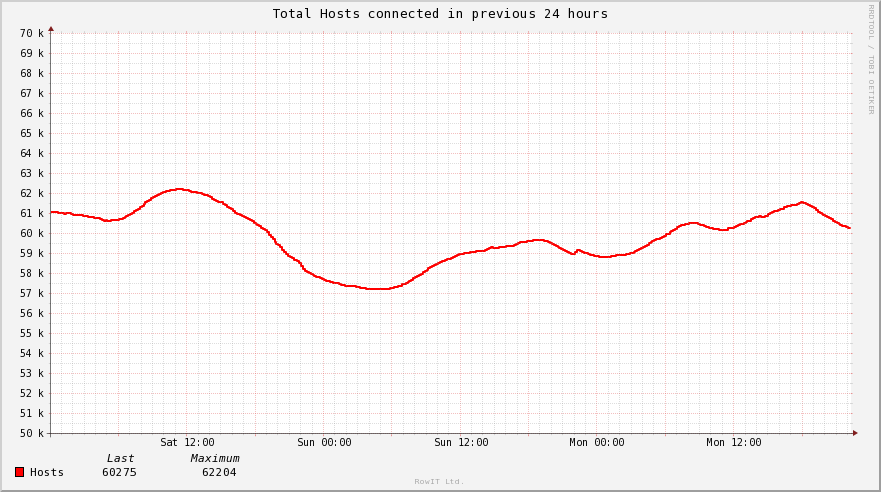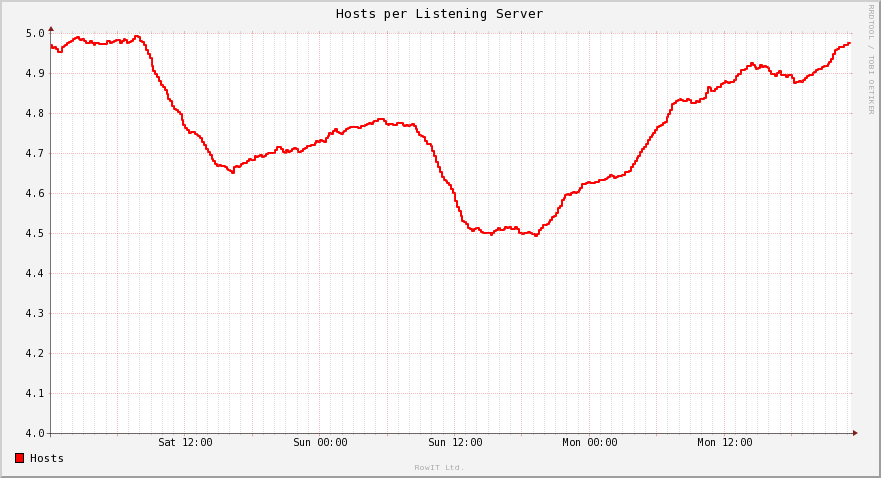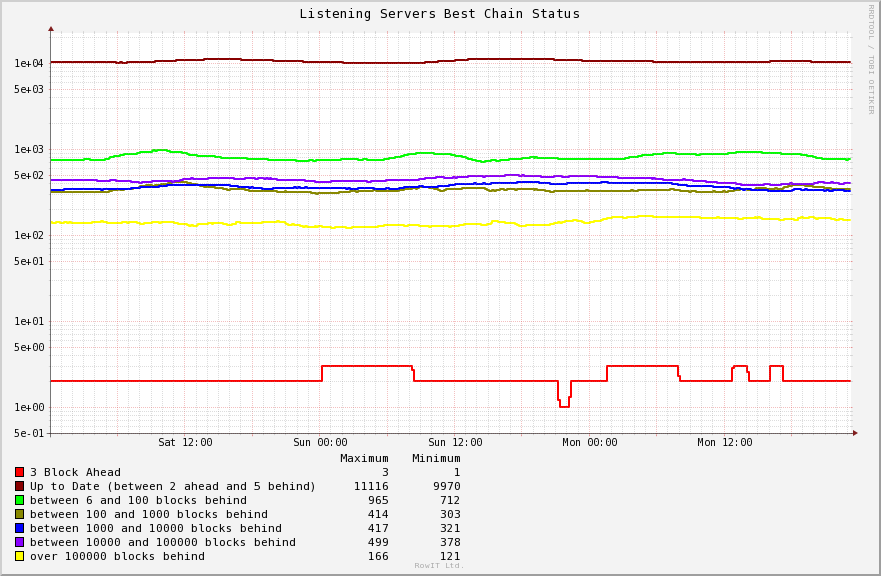Current Network Status: Difference between revisions
No edit summary |
m →Block Chain Availability: spelling |
||
| (3 intermediate revisions by one other user not shown) | |||
| Line 1: | Line 1: | ||
Bitcoins day to day functionality depends on the peer to peer network. This is just a collection of bitcoin clients running on various machines across the internet. The health of that network is critical to the functioning of the bitcoin currency. | |||
Bitcoins day to day functionality depends on the peer to peer network. This is just a collection of bitcoin clients running on various machines across the internet. | |||
===Total Number of Bitcoin Clients=== | ===Total Number of Bitcoin Clients=== | ||
| Line 12: | Line 10: | ||
===Ratio of Listening to Total Number of Hosts=== | ===Ratio of Listening to Total Number of Hosts=== | ||
All hosts are configured to make 8 outgoing connections. With this and the fact that there is a limit of 125 total connection once the ratio of total hosts to listening hosts approaches 15 there will be issues with hosts | All hosts are configured to make 8 outgoing connections. With this and the fact that there is a limit of 125 total connection it can be concluded that once the ratio of total hosts to listening hosts approaches 15 there will be issues with hosts being unable to connect to the network. As of September 2011 this ratio is between 4 and 5<ref name="bitcoinstatus" /> so is not an issue. | ||
[[File:HostServerRatio.png|400x200px]] | [[File:HostServerRatio.png|400x200px]] | ||
===Block Chain Availability=== | ===Block Chain Availability=== | ||
In order for the network to be stable the current blockchain must be downloadable from the majority of clients on the network. As part of the handshake when a client | In order for the network to be stable the current blockchain must be downloadable from the majority of clients on the network. As part of the handshake when a client connects to another client it informs them of the length of blockchain that it has. Currently (September 2011) the network has over 10,000<ref name="bitcoinstatus" /> clients that are listening and have an upto date version of the blockchain. Should this number drop significantly (e.g. due to a network partition or DDOS attack) there would be issues in ensuring that all clients agreed on the current best chain. | ||
[[File:BlockChainStatus.png|400x200px]] | [[File:BlockChainStatus.png|400x200px]] | ||
Latest revision as of 23:16, 23 May 2012
Bitcoins day to day functionality depends on the peer to peer network. This is just a collection of bitcoin clients running on various machines across the internet. The health of that network is critical to the functioning of the bitcoin currency.
Total Number of Bitcoin Clients
There are currently as of September 2011 approximately 60,000[1] active clients. We know this because as part of the protocol every client broadcasts their address across the network every 24 hours. By listening for these broadcasts and counting the number of unique addresses we can count the number of clients.
Number of Listening Bitcoin Clients
One of the issues that the peer to peer network faces is the fact that most users of the internet use machines that are behind a Firewall/NAT gateway. This means that they are only able to make outgoing connections to hosts on the internet and not receive incoming connections (unless they manually or automatically - using PnP - configure their firewall). There are over 12,000[1] bitcoin clients that can be connected to. This figure is be an underestimate of the actual number of hosts that are not behind a firewall as each host is configured to only accept 125 connections, and so if they are full we would not know if the host was behind a firewall or just ignoring out connection request due to too many connections.
Ratio of Listening to Total Number of Hosts
All hosts are configured to make 8 outgoing connections. With this and the fact that there is a limit of 125 total connection it can be concluded that once the ratio of total hosts to listening hosts approaches 15 there will be issues with hosts being unable to connect to the network. As of September 2011 this ratio is between 4 and 5[1] so is not an issue.
Block Chain Availability
In order for the network to be stable the current blockchain must be downloadable from the majority of clients on the network. As part of the handshake when a client connects to another client it informs them of the length of blockchain that it has. Currently (September 2011) the network has over 10,000[1] clients that are listening and have an upto date version of the blockchain. Should this number drop significantly (e.g. due to a network partition or DDOS attack) there would be issues in ensuring that all clients agreed on the current best chain.
- ↑ 1.0 1.1 1.2 1.3 Sourced from BitcoinStatus, web site displaying numerous stats on the bitcoin network.


